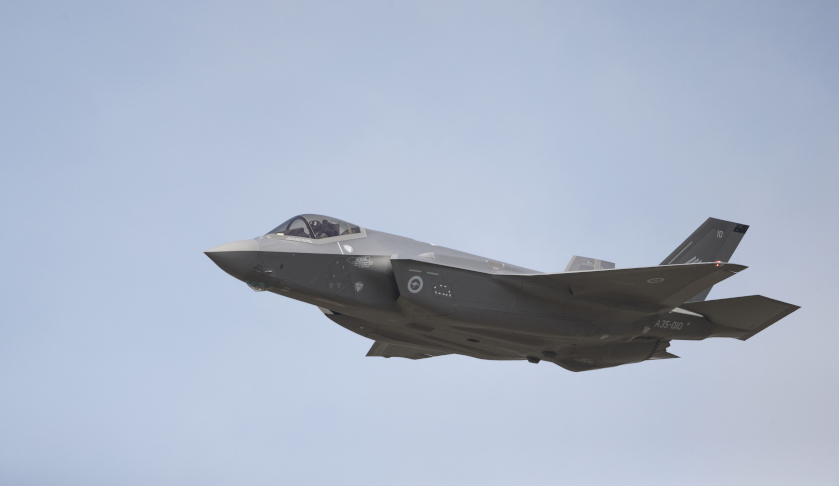Exercise Red Flag 19 has wrapped up with the F-35 Joint Strike Fighter demonstrating the lethal air-to-air capabilities of the fifth-gen platform in a series of near-peer air combat drills.
The Exercise Red Flag series is hosted by the United States Air Force 414th Combat Training Squadron and is held several times a year with a number of domestic and international participants. Australia has been a regular participant in the Red Flag exercise since 1980.
Aircraft and personnel deploy to Nellis Air Force Base in Nevada for Red Flag under the Air Expeditionary Force concept and make up the exercise’s “Blue” forces. By working together, these Blue forces are able to utilise their diverse capabilities to execute specific missions, such as air interdiction, combat search and rescue, close air support, dynamic targeting and defensive counter air.
These forces use various tactics to attack NTTR targets such as mock airfields, vehicle convoys, tanks, parked aircraft, bunkered defensive positions and missile sites. Targets are defended by a variety of simulated “Red” force ground and air threats to give participant aircrews the most realistic combat training possible.
Exercise Red Flag was established in 1975 as the brainchild of Colonel Richard “Moody” Suter and one of the initiatives directed by General Robert J. Dixon, then commander of Tactical Air Command, to better prepare our forces for combat.
Lessons from Vietnam showed that if a pilot survived his first 10 combat missions, his probability of survival for remaining missions increased substantially. Red Flag was designed to expose each “Blue 4” pilot to his first 10 “combat missions” at Nellis AFB, allowing him to be more confident and effective in actual combat.
2019 saw the F-35 return to Exercise Red Flag to participate in a series of high-intensity, complex and peer adversary aimed air combat missions, testing man and machine to the limits, particularly in “contested or denied environments”, which employ active electronic attack, communications jamming and active GPS denial, severely hindering the modern warfighter.
During this phase of the testing, the F-35 positioned itself as one of the key “combat battlefield” coordinators, responsible for collecting, managing, analysing and distributing intelligence data to the Blue Force all while prosecuting attacks against threats, returning to an advanced information collector and distributor for older fourth and 4.5 generation fighter aircraft via Link-16.
Lieutenant Colonel Yosef Morris, US Air Force 4th Fighter Squadron commander, said, “Those situations highlight the fifth-generation capabilities of the F-35. We’re still able to operate and be successful. In a lot of cases, we have a large role as an integrated quarterback. Our ability to continue to fuse and pass information to the entire package makes every aircraft more survivable.”
As part of the first week of exercises, F-35s flew as part of a large force in a counter-air mission against more than 60 “aggressor” aircraft, which leveraged advanced electronic attack capabilities to blind the Blue Force fleet of fourth-generation aircraft to both air and surface-based threats.
The F-35’s unique blend of low-observable stealth technologies, combined with the airframe performance and “sensor fusion” enabled the pilots to reshape both the battlespace and the battles themselves: “With stealth, the F-35 can get closer to threats than many other aircraft can. Combined with the performance of the fused sensors on the F-35, we can significantly contribute to the majority of the missions,” LTCOL Morris added.
Red Flag is not a rolling campaign, the exercises are made up of different scenarios that increase in difficulty as the weeks go on. This allows the integrated force to learn how best to capitalise on the strengths and protect the weaknesses of each platform in very specific mission sets.
The evolving nature of the exercises has demonstrated the capability of the F-35 to operate and survive in complex, high-intensity combat situations, seemingly addressing capability concerns about the aircraft, raised throughout the history of the world's largest defence project.
“Even in this extremely challenging environment, the F-35 didn’t have many difficulties doing its job. That’s a testament to the pilot’s training and the capabilities of the jet,” said Colonel Joshua Wood, US Air Force 388th Operations Group commander.
For Australia, the success of the fifth-generation fighter aircraft comes as a vote of confidence in the Royal Australian Air Force’s future fighter fleet. Over the coming years, Australia will purchase 72 of the advanced fifth-generation fighter aircraft as part of the $17 billion AIR 6000 Phase 2A/B program – which is aimed at replacing the ageing F-18A/B Classic Hornets that have been in service with the RAAF since 1985.
Ten nations are currently flying F-35s, including the US, UK, Italy, Norway, Israel and Japan. More than 340 F-35s are operating today with partner nations, more than 700 pilots and 6,500 maintainers have been trained, and the F-35 fleet has surpassed more than 170,000 cumulative flight hours.








